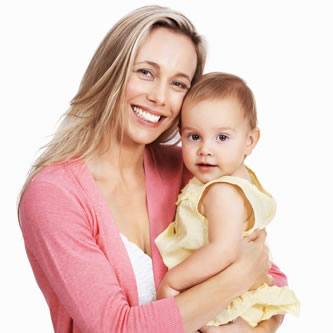Dental Care For Your Baby
Congratulations on the arrival of your baby! Are you prepared for the arrival of your baby’s first tooth? Follow these guidelines and your son or daughter will be on the way to a lifetime of healthy smiles!
Caring for Gums
Even before your baby’s first tooth appears, the gums can benefit from your careful attention. After breast- or bottle-feeding, wrap one finger with a clean, damp washcloth or piece of gauze and gently rub it across your baby’s gum tissue. This practice both clears your little one’s mouth of any fragments of food and begins the process for building good daily oral care habits.
Baby’s First Tooth
When that first tooth makes an appearance, it’s time to upgrade to a baby toothbrush. There are usually two options: a long-handled toothbrush that you can hold in the grip of your hand, or a finger-puppet-like brush that fits over the tip of your pointer finger. In each case, the bristles are soft and few.
At this stage, toothpaste is acceptable but not necessary; just dip the brush in water before brushing. If your little one doesn’t react well to the introduction of a toothbrush, don’t give up. Switch back to a damp washcloth for a few days or weeks and try the toothbrush again. During the teething process, your child will want to chew on just about anything, and a baby toothbrush with a teether can become a favorite toy during this period.
Brushing with Toothpaste
When a few more teeth appear, you can start using toothpaste with your child’s brush. At this stage, use only a tiny amount of fluoridated toothpaste. The American Academy of Pediatric Dentistry (AAPD) recommends using a smear or rice-size amount of fluoridated toothpaste for children younger than three years old. Parental assistance is key! From the beginning, have your little one practice spitting the toothpaste out after brushing, which should not be swallowed at any age.
Avoiding Cavities
Any type of sweetened liquids can increase the risk for getting cavities, so it is best to avoid introducing beverages such as flavored drinks, fruit juice, or soda. Even the sugars present in formula and milk (this goes for breast milk as well) can cause decay once children begin eating table foods, so regular teeth and gum cleaning is important from an early age. Also, it is advised to not put your baby to bed with a bottle, as this could lead to prolonged contact of sugary liquids on the teeth and lead to early childhood decay ("baby bottle decay").
First Visit to the Dentist
It is recommended that your child have his or her first dental visit within six months of the first tooth’s eruption – usually around his or her first birthday. Since tooth decay can occur at even the early stages of tooth eruption, we will focus your first dental appointment on ways to avoid dental problems. Remember that preparing for each dental visit with a positive attitude goes a long way toward making your child comfortable with regular checkups.
Setting a Good Example
As part of the natural learning process, little ones are expert mimics, and you can take advantage of this talent. Brush and floss daily while your child is watching, and he or she will intuit at an early age the importance of your good habits. As soon as your child shows interest, offer a toothbrush of his or her own and encourage your toddler to “brush” with you. (A quick note: the bacteria that cause cavities can be shared from parent to child, so please don't share a toothbrush). Most children don’t have the dexterity necessary to thoroughly clean their own teeth until they’re at least six or seven years old, so we recommend that you play an active role in the process. There are lots of ways to make toothbrushing interesting and fun: trying different flavors of toothpaste, choosing a toothbrush with a cool design or favorite character, singing a song, or listening to a toothbrushing story or podcast. The primary goal is to practice healthy oral habits at an early age that will set your child up for a lifetime of healthy, cavity-free teeth!


